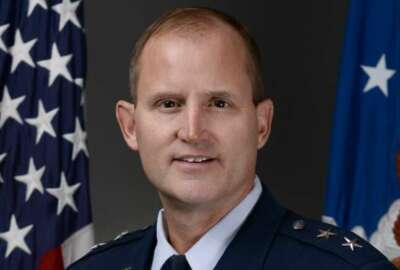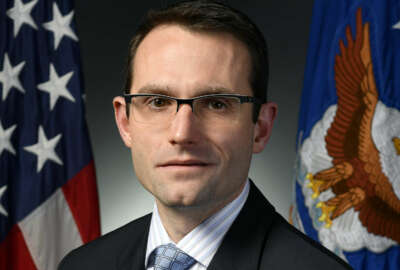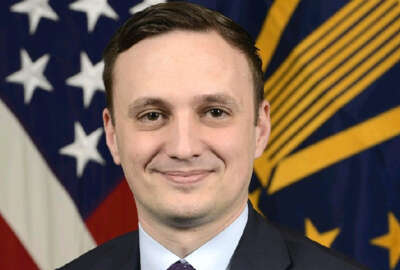
Study offers recommendations for retaining Air Force civilians
The Air Force has a well-known problem of keeping its pilots around. Maybe the crash of the airline industry will help? But it also has the challenge of retaining...
Best listening experience is on Chrome, Firefox or Safari. Subscribe to Federal Drive’s daily audio interviews on Apple Podcasts or PodcastOne.
The Air Force has a well-known problem of keeping its pilots around. Maybe the crash of the airline industry will help? But it also has the challenge of retaining its best civilians. That’s the subject of a RAND Corporation study which has a list of recommendations for the advancement and retention of the Air Force white collar crew. Maria Lytell, associate director for the Personnel, Training, and Health Program at RAND’s Arroyo Center, and Kirsten Keller, senior behavioral scientist and associate director for Manpower, Personnel, and Training Program at the RAND Project Air Force, joined Federal Drive with Tom Temin for more details.
Interview transcript:
Tom Temin: Joining me with details, the Associate Director for the Personnel Training and Health Program at RAND’s Arroyo Center, Maria Lytell. Mrs. Lytell, good to have you on.
Maria Lytell: Hello.
Tom Temin: And the senior behavioral scientist and Associate Director for Manpower, Personnel and Training Program at the RAND Project Air Force, Kirsten Keller. Mrs. Keller. Good to have you on.
Kirsten Keller: Hello, thank you for having me.
Tom Temin: Let’s begin at the beginning here. What is it you were trying to find out about the Air Force when they retained you for the study?
Kirsten Keller: So the Air Force asked RAND Project Air Force, which is a federally funded research and development center for the Air Force, to really look at how it could ensure that it’s growing and retaining civilian talent across all demographic groups in the Air Force. And so to that end, they asked RAND Project Air Force to conduct a study aimed at trying to develop a better understanding of potential barriers to advancement and retention for three groups, women, racial ethnic minorities, and then individuals with disabilities.
Tom Temin: And what were your key findings? Anything that you might not have guessed at the outset?
Maria Lytell: Hi, this is Maria, I would say the biggest finding we had involved women — and the study, although it was focused on advancement and retention, what we found was that in our quantitative data analysis that Air Force civilian women tend to enter air for civil service at lower pay grades than men on average. In fact, we found that controlling for a variety of factors like education, occupation level, that women tend to enter civil service about 1.3 grades lower on average than men. And women are over 20 percentage points less likely than men to begin their careers at the general schedule grade of 11 or higher. And so we did some analyses to try to understand what might explain that entry gap. We find the factors like the types of occupations that women enter, veteran status, so military veteran status and work experience explain most of that gap.
Tom Temin: Yeah, let me make sure I understand that so that for a given level of experience and education, a woman would come into the Air Force at a lower grade level than a man would.
Maria Lytell: Yeah, it does control for a variety of factors. It’s a little bit complicated. We did some type of analysis that decomposes the differences. So yes, it would say that, if you control for things like occupational series, veteran status and work experience, you do find these differences. Actually, what is a more fair characterization is that the gender gap is mostly explained by those factors, that veteran status, occupation and work experience explain most of the gender gap, that it’s those kinds of characteristics, those differences between the male and female population that explains the gap. That is not because of being a woman or a man, it’s because they have different distributions of those characteristics.
Tom Temin: So that would seem to mitigate in favor of how they go about job searching maybe — it’s not so much as the choices in hiring when they do hire.
Maria Lytell: It’s a little bit complicated. So what’s interesting is that and our analysis can’t really keep us apart, because we’re using administrative personnel records. So there’s broader gender kind of segregation in terms of occupations in the US economy, which is something that the Air Force inherits to some level. But the civilian jobs in the Air Force are also somewhat different than the jobs in the private sector or the civilian sector more broadly. And a lot of those kinds of jobs tend to favor types of skills that military veterans pick up. So for example, one of the things that you see is that a couple of occupations that have higher grade levels at entry are ones that tend to be mostly occupied by veterans by retired officers, like Aircraft Operations. And so since women tend to enter Air Force civil service, and they’re not veterans, there’s this confound of veteran status and occupational series. So it’s a little bit complicated.
Tom Temin: Yes. Nothing you can jump to conclusions about. And what about minorities and people of color? What were the main findings?
Maria Lytell: Yeah, well, we did find an entry level gap between Black men and white men as well as Hispanic men and white men. A similar nature as the gender gap, but smaller and similar kinds of factors explain the gap, except there’s more of the gap that is unexplained, meaning the data can’t tell us what explains the gap. But it’s a smaller gap. It’s about a one pay grade lower entry point on average for Black and Hispanic men compared to white men. So we did find something similar the gender gap, but it’s just not as large of a gap. We’re
Tom Temin: And with this knowledge, what are your recommendations that the Air Force can do if they want to get more people of color and women into the upper management ranks, higher pay grades in the civilian side?
Kirsten Keller: Sure. So we have three primary overarching recommendations. The first is we talked about that we did identify particularly some entry level gaps for women and racial ethnic minority groups. So one of our first recommendations that we weren’t able to do within the current study is really to try to identify those root causes for the entry gaps. So that’s looking at things like what do the applicant pools look like? Are there fewer women entering occupations that have greater advancement opportunities? Looking at the type of recruiting that’s done, or looking at the different hiring and selection practices. So again, we weren’t able to do that as part of our study. But that’s certainly something that we recommend looking into that more to try to identify what could be those root causes for the entry level gap. The second thing that we recommended was ensuring that supervisors and managers take responsibility for career development and disability management of their staff. So one of the things that we heard in a series of focus groups and interviews that we did across different installations and with different demographic groups in the Air Force really suggested that not all supervisors and managers consider staff career development is their responsibility in the same way. So certainly, the Air Force has policies and procedures that are designed to ensure this, but it seems that in practice, these may not be happening. And so we were trying to make recommendations to the Air Force to think about ways that they can make sure they’re holding people accountable, in terms of ensuring that supervisors are really required to engage in staff career development, that all supervisors and managers are familiar with disability requirements, and are able to educate their staff on those and what accommodations they can have. And then really ensuring that Air Force guidance is up to date regarding position descriptions, and career guidance, things like that, that can be communicated to staff. And then finally, our third recommendation really focused on again, monitoring the advancement and retention of certain civilian demographic groups that we did find to have lower than expected advancement or retention rates. So for example, we found that Asian men in particular have lower than expected advancement rates when they get past eight years of service and trying to dig into that a little bit more and see how that might occur in the future. So continuing to monitor those trends.
Tom Temin: Got it. So you can’t just have a diverse hiring cohort, and then kind of let it rip, you’ve got to keep your hand on the controls a little bit to make sure that people advance in the numbers, you would expect them to advance with all of these factors being equaled out.
Kirsten Keller: That’s right. So there are multiple steps to really that career development process, right. It’s looking at the hiring, who you’re bringing in, and then making sure that everybody is advancing and also looking at retention, right. Because advancement is both about promotion, and then who you’re retaining to get that pool of potential senior leaders.
Tom Temin: And for other organizations that might want to undertake this type of study, just briefly survey the sources and types of data that you use. You mentioned several times, it was a data analytic based look followed up by some in person, I guess, interviews, but what about the data? Maria?
Maria Lytell: Thank you. Yes. So we use the mixed method approach, as you noted, and we did basically two types of data sources, one was quantitative in nature. So one of the great things about having this long standing relationship with the Air Force through Project Air Force at RAND, is that we work with the Air Force to access years of administrative personnel records. I mean, we’re talking 22 years of data that we were able to harness between fiscal year 1994 and 2016. And so we’re able to go back and look at patterns over time, in terms of education, occupation, demographics, etc. Those data are retained by the Air Force or their personnel headquarters. And the other services do similar kinds of data collection. So if this were private sector firm, it would be HR data, essentially. And so it takes complex modeling and analysis to harness those data. But as Kirsten mentioned, we also conducted focus groups and supplementary interviews with Air Force civilians across 10 bases, across demographic groups, as well as groups of civilians with disabilities to get a deeper understanding of some of the challenges they may face in terms of promotion or retention. And so we use both sets of data to inform the other in terms of our recommendations. So here’s to mention three recommendations. The first one about root causes at entry was really driven by our quantitative findings. But our second recommendation about supervisors taking more of a role in crew development really came from the focus groups and interviews, what we heard from civilians, who were really interested in getting more feedback about their opportunities. And so that’s where that recommendation came from.
Tom Temin: So you’ve given the Air Force a homework assignment.
Maria Lytell: Yes, it’s often the case with these kinds of complex topics like diversity that you uncover gaps potentially. But getting at the root causes takes a lot more digging because there’s so many contextual factors involved. And with the civilian workforce in particular giving that hiring decisions tend to be local — it does get a lot more complicated.
Tom Temin: Maria Lytell is the Associate Director for the Personnel Training and Health Program at RAND’s Arroyo Center. Thanks for joining me.
Maria Lytell: Thank you for having me.
Tom Temin: And Kirsten Keller is senior behavioral scientist and Associate Director for Manpower, Personnel and Training at the RAND project Air Force. Thank you also,
Kirsten Keller: Thank you for having me.
Copyright © 2025 Federal News Network. All rights reserved. This website is not intended for users located within the European Economic Area.
Tom Temin is host of the Federal Drive and has been providing insight on federal technology and management issues for more than 30 years.
Follow @tteminWFED





